|
|

|
1940 to 1949
The Second World War changed the face of air travel
with the flying boat era disappearing as new land-operating aircraft were
developed for war and later moved into airline design.
The war left the world, and especially
Europe, with a glut of large airbases with long concreted runways and
large 'dispersal' aprons and hanger complexes. This led naturally to
land-based airline services after the war's end.
After the war new new airports were
designed (like the London Heathrow airport west
of London) to be closer to Europe's main citys. Some pre-war types were
used for a while on international services, although ex-USAAF aircraft
were mostly pressed into European routes while European countries
re-started their own national aircraft industries.
Converted war planes were also used
to fill the space between the design of new purely civilian types and
their introduction with the airlines. Lancastrians, Yorks and C-47s
(military DC3s with large cargo doors on the port side) were in use by the
airlines in this immediate post-war period and were used on the Berlin Air
Lift directly after the war in Europe ended.
By the late 1940s new types were to
be seen at Europe's new airports. Heathrow and
Northolt saw the beginning of the European state airline BEA and it's new
types including the Viking and Ambassador. With the longer range Douglas
DC6s and 7s, Lockheed's Constellation and Boeing's Stratocruiser
trans-Atlantic services were had come of age with Pan American World
Airways and Trans World Airways flying between New York and London
Heathrow daily.
|
Avro Anson 19
Airline: Brain & Brown Airfreighters 1970s (1944) Country: UK
This was a conversion of the RAF's Anson communications aircraft, which had
a turret in the mid-dorsal area.
|
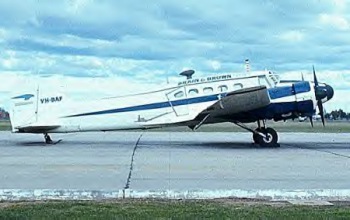 |
|
|
Avro
Lancastrian
Airline: Alitalia (1947) Country: UK
9 seats or cargo/mail
4 Merlin engines
275 mph cruise
Span 102 feet
Length 77 feet
The Lancastrian was an Avro Lancaster bomber conversion for immediate
post-war airline use (by BOAC, BSAA, Alitalia, Qantas and TCA)
|
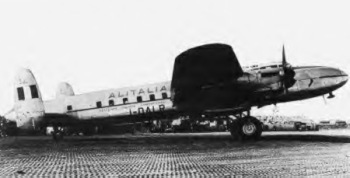 |
|
|
Avro Tudor
Airline: Air Charter London Ltd Country: UK
4 Merlin engines
The Tudor was one of Britain's first post-war airliners to take over from
the Lancastrians and Yorks. It was not successful. It was mostly used by
British South American Airways who lost three in the South Atlantic.
|
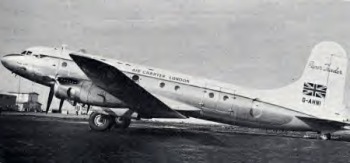 |
|
|
Avro York
Airline: Skyways of London in 1962 (1944) Country: UK
24 passengers
4 Rolls Royce Merlin engines
210 mph cruise
Span 102 feet
Length 78 feet
The York was built in 1944 as a RAF military troop transport. It flew into
the late 1960s with Dan-Air London, a UK charter airline.
|
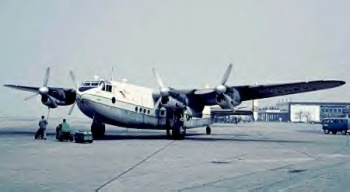 |
|
Boeing SA-307b Stratoliner
Airline: Transcontinetal & Western Air (TWA) (1940) Country: USA
44 passengers
4 Wright GR.1820 engines
184 mph cruise
Span 107 feet
Length 74 feet |
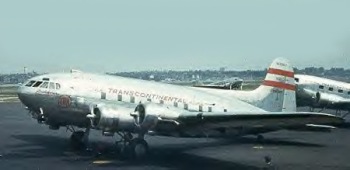 |
|
|
Boeing B.377 Stratocruiser
Airline: Boeing's prototype Stratocruiser (1949)
81 passengers
4 P&W R4360 engines
285 mph cruise
Span 141 feet
Length 110 feet
The Stratocruiser was a successful long-haul airliner. It had a luxurious
pressurised cabin with sleeping bunks and was considered the most
luxurious way to fly the Atlantic.
|
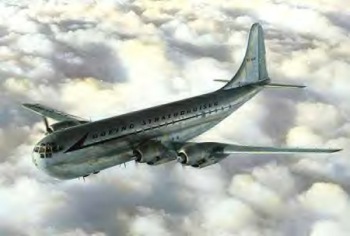 |
|
|
Breguet 763 Universal (Deux
Ponts)
Airline: Air France at Orly in 1969 (late 1940s)
Passengers or cargo
4 piston engines
The prototype '761' was modified with a middle fin in the tail to '763'
specification. It was used by Air France for it's North African province
network. Air Algerie also used the type. It had twin-decks, thus the
nick-name 'deux-ponts' Air France used it for cargo operations until the
early 1970s.
|
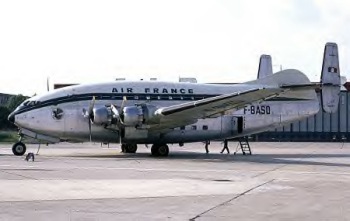 |
|
|
Bristol 170 Mk.11 & Mk.22 Freighter
Airline: Bristol's prototype Mark 11 Freighter (1944) Country: UK
Cargo and pax (2 automobiles and their passengers)
2 Bristol Hercules engines
164 mph cruise
Span 108 feet
Length 68 feet
The Freighter mark 11, mark 21 and mark 31 looked similar with a
snub-nose, unlike the mark 32 'Super-Freighter' variant. It was originally
designed to carry holiday makers and their cars across the English
Channel. In the 1960s it was also used to carry livestock and outsized
loads. |
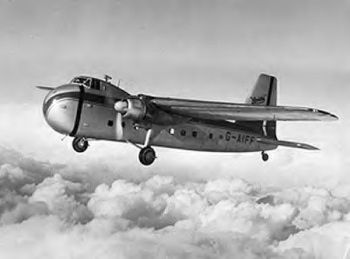 |
|
Bristol 170 Mk.31
Freighter
Airline: Aer Turas Mk.31 Freighter used for livestock in 1969
Country: UK
Cargo and pax (2 automobiles and their passengers)
2 Bristol Hercules engines
164 mph cruise
Span 108 feet
Length 68 feet
The Freighter Mark 31 looked similar to earlier variants with a snub-nose. |
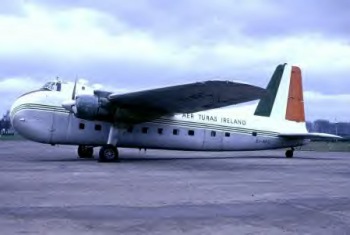 |
|
Bristol 170 Mk
32 Super Freighter
Airline: Channel Air Bridge (1960) Country: UK
40 passengers or 20 passengers with 3 cars
2 Bristol 734 engines
191 mph cruise
Span 108 feet
Length 74 feet
The Mark 32 was the final variant of this unusual car transporter. With a
the clam-shell door nose extended by six feet it could carry three cars
and their passengers and gained fame on the cross channel services flown
by Silver City and Channel Airways. |
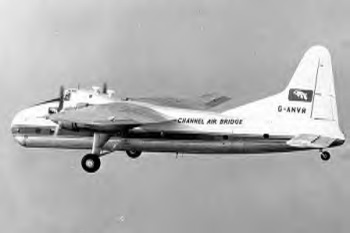 |
|
Canadair
C-4 Argonaut
Airline: British Midland Airways Country: Canada
50+ passengers
4 Rolls Royce Merlin engines
200+ mph cruise
The Argonaut was a pressurised and Merlin powered Douglas DC-4 built in
Canada. |
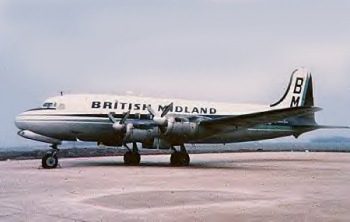 |
|
Consolidated
PBY-5 Catalina
Airline: Cathay Pacific Airways (1943) Country: USA
22 passengers
2 Pratt & Whitney 1830 engines
124 mph cruise
Span 104 feet
Length 68 feet
The Catalina was a military maritime patrol and SAR amphibian. Several
airlines used Catalinas during the war including Qantas and Cathay
Pacific. This versatile aircraft could land on a runway or in a secluded
bay and was ideal for communications flights in the war. |
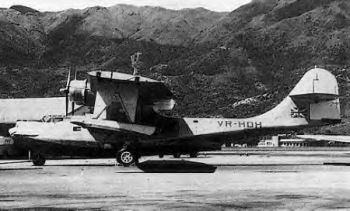 |
|
Convair-liner CV-240
Airline: American Airlines was the launch customer (1947) Country:
USA
40 passengers
2 P&W R2800 engines
235 mph cruise
Span 92 feet
Length 75 feet
The Convair Cv-240 was the first of several successful twin-engined
short-haul airliners built for 2nd-level US carriers serving the US
domestic market. |
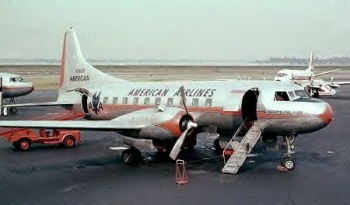 |
|
Convair-liner 340
Airline: Convair's prototype 'Convairliner-340' (1953)
44 passengers
2 P&W R2800 engine
280 mph cruise |
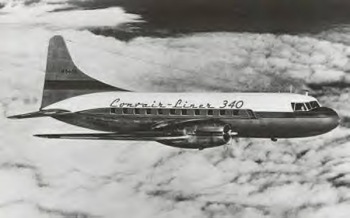 |
|
Curtiss
C46 Commando
Airline: Pacific Western in 1958 (1946) Country: USA
40 passengers
2 P&W R2800 engines
187 mph cruise |
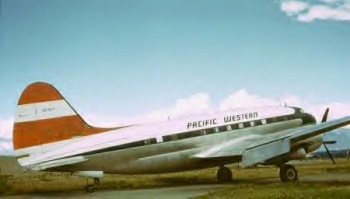 |
|
Douglas DC-4E
Airline: Douglas's prototype DC-4E (1946)
56 seat
4 P&W R2000 engines
204 mph cruise
This was the first version of the now famous DC-4. Luckily Douglas decided
to go for a single-deck simple design rather than this complex
double-decker, multi-fin design. The DC-4E was exported to Japan in small
numbers though. |
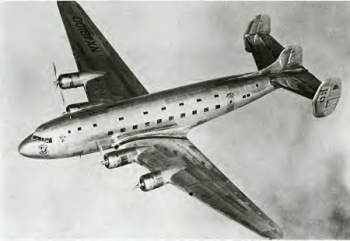 |
|
Douglas DC-4
Airline: Douglas's prototype DC-4 (1946) Country: USA
56 seat
4 P&W R2000 engines
204 mph cruise
Span 117 feet
Length 93 feet
This was used during the war years by the USAAF for troop and cargo
transport. The military version, known as the C-54 Skymaster, had a
large cargo door at the rear-port side of the fuselage. The C-54 was used
by countless airlines directly after the war and along with the C-47
(military version of the DC-3) it was instrumental in getting the world's
airlines flying in 1946. |
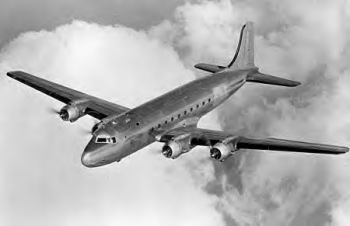 |
|
Douglas DC-5
Airline: Douglas's prototype NX21701 (1940) Country: USA
16 passengers
2 Wright Cyclone engines
195 mph cruise
Span 78 feet
Length 62 feet
The Douglas DC-5 only had one airline operator - KLM Royal Dutch Airlines.
This sleek but small feeder airliner simply didn't fit the needs of the
USA's own domestic second-level airlines. The DC-3 suited them well, as it
did most of the worlds' carriers of the time. |
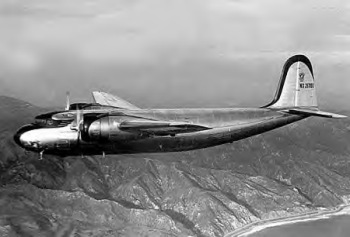 |
Douglas DC-6A
Airline: the prototype DC-6A aircraft (1946)
82 passengers
4 Wright R2800 engines
270 mph cruise |
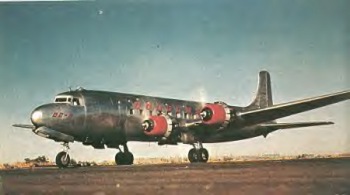 |
|
|
Douglas DC-6b
Airline: The prototype DC-6B (1946) Country: USA
82 passengers
4 Wright R2800 engines
270 mph cruise
Span 117 feet
Length 106 feet
The DC-6B was the successful variant of the type with the DC6A being
little used outside America. The DC6B is one of the greats of airliner
history and stands alongside the DC-3 Dakota in that it can still be found
flying airline operations today, over 50 years after it was designed.
|
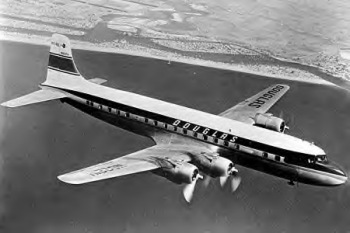 |
|
|
Douglas DC-7C
'Seven-Seas'
Airline: National Airlines (1957) Country: USA
69 passengers
4 Wright R3350 engines
330 mph cruise
Span 127 feet
Length 112 feet
The DC-7C variant was known as the 'Seven-Seas' and loved by the
airlines. It was the equivalent of the Lockheed Starliner and had range
and payload - an aircraft that could finally cross the Atlantic both ways!
It's life in the main airlines of the day was short-lived though. Two
years after it came into service the jet-age dawned and the age of the
piston airliners was over. |
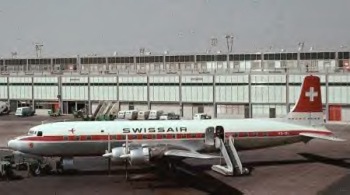 |
|
Handley-Page Halifax
Airline: London Aero & Motor Servces Ltd (1946)
Passengers or cargo/mail
The civil Halifax was an Halifax bomber conversion for immediate post-war
airline use. |
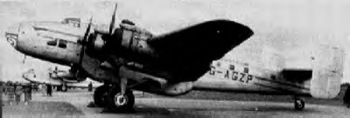 |
|
Handley-Page Hermes 4
Airline: Air Links in 1963 (1952)
4 engines
The Hermes was one of the British airliners designed in the latter part of
the war. By the time it was in production it was already out of date,
compared to the US airliners like the DC-4 and Boeing Stratocruiser.
BOAC placed an order for the type but it was soon replaced by American
airliner types. It continued into the early 1960s with British charter
airlines like Silver City, Air Links, Britavia and Air Safaris. |
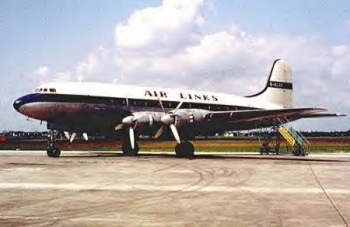 |
|
Ilyushin IL-12
Airline: CSA in the 1950s (1947)
28 passengers
2 Shvetsov Ash 82 engines
205 mph cruise
The Ilyushin IL-12 was used for short and medium haul routes by Russia and
it's satellite nations. |
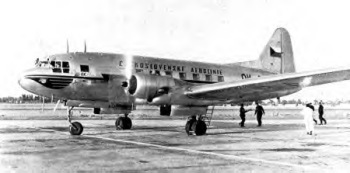 |
|
Ilyushin IL-14
Airline: LOT (Poland) (1949)
2 Shvetsov engines
205 mph cruise
The IL-14 was a replacement for the earlier model IL-12 for Soviet block
airlines. |
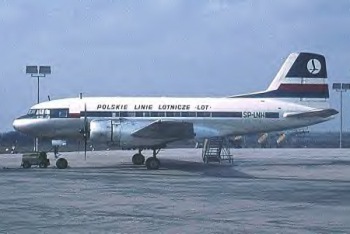 |
|
Lockheed L.049
- L749 Constellation
Airline: Capital Airlines 1958 (1944) Country: USA
69 passengers
4 Wright R3350 engines
270 mph cruise
Span 123 feet
Length 95 feet
The original Constellation L-049 was partly designed for the US military
although large numbers saw airline service. The L-649 was the first purely
civilian 'Connie' to be produced. The 'standard' Constellation variants
ended with the L.749. |
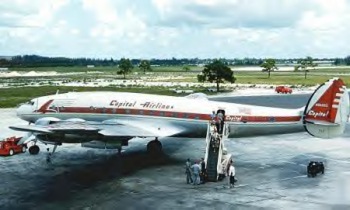 |
|
Lockheed L.1049G Super Constellation
Airline: Air India in 1958 (1952)
92 passengers
4 Wright R3350 engines
255 mph cruise
Span 123 feet
Length 114 feet
The range of 'Super Connies' from L.1049 to L.1049H was successful. The
L.1049G - known as the 'Super-G' was a favourite with many airlines and
saw them into the jet-age. |
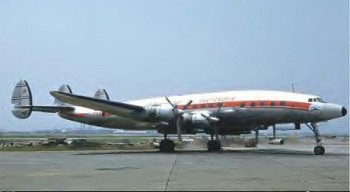 |
|
Martin 2-0-2
Airline: Allegheny Airlines in 1961 (1947) Country: USA
42 seats
4 P&W R2800 engines
250 mph cruise
The Martin 2-0-2 was an early twin airliner designed specifically as a
DC-3 replacement on feeder routes in the USA. The Convair liner range of
aircraft took the market though. |
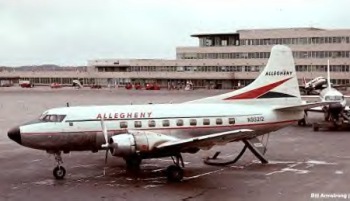 |
|
Savoia-Marchetti S.M.95
Airline: Alitalia (1940s) Country: Italy
24 passengers
4 Alfa-Romeo 128RC engines
186 mph cruise
Span 112 feet
Length 73 feet
This sleek airliner operated Alitalia services after the war years. |
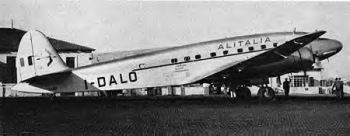 |
|
Short S.45 Solent
Airline: Tasman Empire Airways -TEAL (1949) Country: UK
30 passengers
4 Bristol Hercules engines
241 mph cruise
The Solent was the biggest of the Short seaplane series and the last
flying boat that was made in the UK. By this time landplanes had taken
over completely from the pre-war long-haul flying-boat structure.
Originally built for BOAC they were used by TEAL in New Zealand and later
by Aquila Airways, a 1950s British holiday charter airline. |
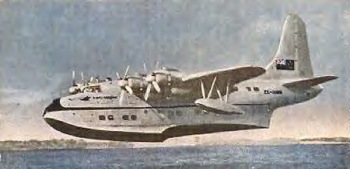 |
|
Sud Est SE161
Languedoc
Airline: Air France F-BCUN (1947) Country: France
33 passengers
4 P&W R1830 engines
197 mph cruise
Span 96 feet
Length 80 feet
The Languedoc was French built and used by the French flag carrier in the
post-war period. Like the S.M. 95 the Languedoc couldn't compete with the
American stable of airliners and by the mid-1950s both airlines were using
US airliners. |
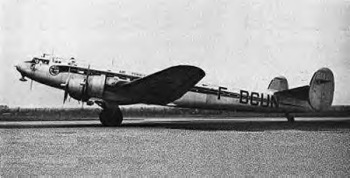 |
|
Vickers-Armstrong Viking 1B
Airline: Air Ferry in 1962 (1946) Country: UK
36 passengers
2 Bristol Hercules engines
193 mph cruise
Span 89 feet
Length 65 feet
The Viking was to be the British-built replacement for BEA's fleet of DC-3
Dakotas. It was introduced in mid 1940s and flew alongside the DC-3s into
the 1950s when the Viscount finally replaced the DC-3s! The Viking fleet
was then sold to many other European airlines and saw holiday charter work
until the end of the 1960s.
It was used by Eagle Airways, Lufthansa, LTU, Air Ferry, Invicta, Air
Safaris, Channel Airways, Pegasus, and Indian National Airlines and
others. |
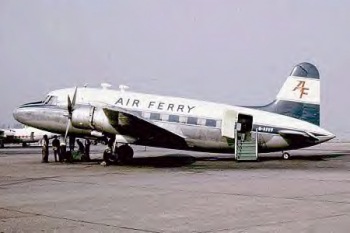 |
|
Vought-Sikorsky VS-44
Airline: Avalon Air Transport (1942) Country: USA
10 passengers
4 P&W Twin-Wasp engines
160 mph cruise
Span 124 feet
Length 79 feet
The VS.44 was one of the last
large flying boats made in the USA and was used by American Export
Airlines and more recently by Avalon Air Transport.
Vought was a military aircraft builder and Sikorsky made a name for
itself, pre-war, building flying boats for names like Pan American and TWA.
|
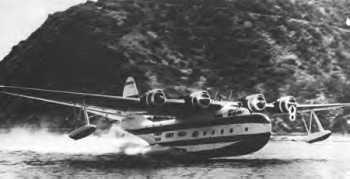 |
|
|
|
|
|
